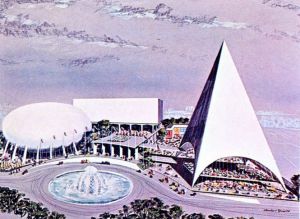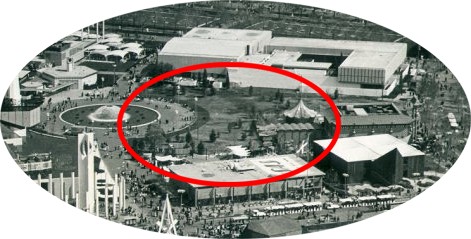|
What the heck is a "World's
Fair Phantom?" Mirriam-Webster defines a phantom as
"something apparent to sense but with no substantial
existence." The 1964-1965 New York World's Fair gave
us more than a few phantoms to explore -- pavilions and exhibits
that were apparent to sense but had no substantial
existence. They failed to materialize for one reason or another
- primarily due to a lack of planning or, more likely, a lack
of funding; for exhibiting at the New York World's Fair was a
very expensive proposition! It's fun and interesting to look
back to see what exhibits we can sense without there being anything
of substance to see. nywf64.com took a
look at a number of these New York World's Fair Phantoms in our
feature presentation Building the Fair. And now, thanks to Mike
Kraus, we can expore in-depth one of the most interesting phantoms
of the Fair - the Pavilion of France.
The Phantom Pavilion of
France
 |
What makes the Pavilion of France different
from most other Fair phantoms is that something tangible actually
existed at one time. While many of the Fair's phantoms never
advanced beyond the concept stage others, like the Pavilion of
France and the World of Food, actually had ground broken,
steel erected and exhibits prepared to be installed in them.
The other tangible phantom, the Pavilion of Argentina, was fully completed
yet Argentina never took occupancy of the building! France did
eventually have a presence at the Fair and in our companion piece
on French participation, nywf64.com takes
a look at The
Pavilion of Paris and French Industry, the privately sponsored
pavilion that fulfilled some of the promise of the Pavilion of
France but was no where near as ambitious or successful as the
planners for the Pavilion of France had sought for their pavilion
to be!
Why did the Pavilion of France disappear
like a ghost into thin air between February 3rd and Labor Day
of 1963? Bruce Nicholson in his book Hi Ho, Come to the Fair
said that the government of France had no problem with a privately
sponsored pavilion representing France as long as "it was
made perfectly clear that it was in no way connected with the
Government of France or the French people." France being
a signatory to the charter of the Bureau of International Expositions,
the World's Fair sanctioning body that was publicly boycotting
the '64 Fair, and host of the headquarters of that organization
in Paris, no doubt found this a political necessity. From that
we can glean that government interference didn't bring about
its doom. But perhaps French pride made potential exhibitors
less than enthused about supporting a decidedly non-French
French pavilion? It's obvious that International Expositions
Corporation had undertaken a massive and very expensive project
in the Pavilion of France. Perhaps the project was just too
ambitious and costly and Anthony B. Golff found it impossible
to find the financial backers or willing French exhibitors to
make his project a reality. What we know for sure is that by
June 19, 1963, International Expositions Corporation and Anthony
B. Golff and his magnificent Pavilion of France were out and
a new contract between the World's Fair Corpation and Exhibitions
de France, Inc. had been signed with Mr. Jacques M. Fisher as
Director General of The Pavilion of Paris and French Industry.
That would now be the official name for French participation
in the Fair. On Opening Day, 1964, the plot allotted to the Pavilion
of France was simply the site of a vacant lot and it would remain
so throughout the run of the Fair.
The site of the Pavilion of
France at the New York World's Fair in 1964 and 1965 remained
a vacant lot throughout the run of the Fair. It's image, however,
lived on!
SOURCE: New
York World's Fair Publicity Photograph presented courtesy Craig
Bavaro collection
 |
The phantom Pavilion of France shares a
particular distinction with only three other phantoms of the
Fair. It's image, along with that of the World of Food, the Arch
of the Americas and the World's Fair Assembly Hall, appears repeatedly
on promotional brochures and souvenirs of the Fair before and
throughout the 1964 and 1965 seasons of operation. Peter and
Wendy, when playing their Official New York World's Fair Game,
must've wondered why they didn't remember seeing the pyramid,
rectangle and egg-shaped buildings that were shown on their playing
board.
nywf64.com takes a look at some of the souvenirs featuring
the Pavilion of France and the other well-known World's Fair
Phantoms ...
|